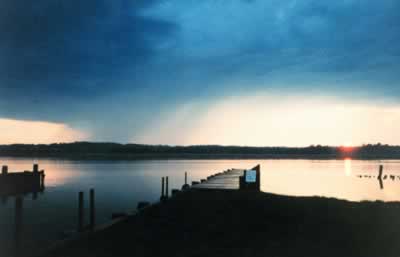 The hydrosphere consists of all the water on the Earth, in all of its states, on and beneath its surface and in its atmosphere. Earth is unique among the planets of our Solar System in that it contains a large amount of liquid water – a medium that supports the chemical reactions necessary for life. Water is what makes our planet appear blue in photos taken from space.
The hydrosphere consists of all the water on the Earth, in all of its states, on and beneath its surface and in its atmosphere. Earth is unique among the planets of our Solar System in that it contains a large amount of liquid water – a medium that supports the chemical reactions necessary for life. Water is what makes our planet appear blue in photos taken from space.
About 97% of the water on Earth consists of salt water from oceans and seas. Saltwater covers 70% of the Earth’s surface. Most freshwater on Earth exists either in the form of ice in glaciers and icecaps or as groundwater - water that flows underground. Aboveground freshwater in rivers, lakes and streams – the water we use for drinking, cooking and bathing - makes up only a tiny percentage of the water on our planet.
Underground, water can exist as a liquid, gas or solid. Hot magma beneath the surface of the Earth can heat water so it becomes steam. When pressure causes underground steam and hot water to erupt through the surface and shoot into the air, a geyser forms. Water beneath the ground can freeze and become ice.
Water exists in all three states in the atmosphere. As a gas, it appears as mist or fog. As a solid, it appears as snow, hail or sleet. It appears in liquid form when it rains. Clouds in the atmosphere are made of droplets of water and crystals of ice.
Hydrologic Cycle
The water on Earth is constantly moving. Wind and tides create ocean currents. Gravity causes river waters to move downhill.
Water also moves to and from the atmosphere and the Earth’s surface, and back and forth above and below ground. As it moves from place to place, its state – whether it is solid, liquid or gas – may also change. This continuous movement of water is known as the hydrologic cycle, or water cycle.
Precipitation occurs when water from clouds falls to Earth in the form of rain, snow, sleet or hail. Some of this water falls onto oceans and lakes, where it is stored. If precipitation falls on land, the rainwater or water from melting snow, hail or sleet will flow downhill, in rivulets. This water is known as runoff. As the water continues to flow, the rivulets will become larger and can combine to form a stream or river. Engineers design sewers to collect runoff so that it does not interfere with human activity.
Sometimes, water that falls on the ground flows through porous rock and soil and ends up below surface. This is called infiltration.
As water moves from the air to the surface, it also moves from the surface to the air via the process of evaporation, the process by which liquid water on the surfaces of oceans, seas, lakes, rivers, streams and puddles becomes vapor.
Plants help send some water back to the air, in a process called transpiration. Roots in the soil draw water into the plant. This water moves upward through the stem by means of capillary action. The plant uses the water for metabolic processes, and the releases some of it through the leaves.
Together, evaporation and transpiration are known as evapotranspiration. About 90% of evapotranspiration consists of evaporation, while only 10% consists of transpiration.
Usually, ice melts and becomes liquid before it can run off along or beneath the ground or evaporate into the air.
Sometimes, however, ice will turn into water vapor without having to melt first. The transformation of a substance directly from solid to liquid form is called sublimation. You will have witnessed sublimation if you have ever seen smoke or fog created by a machine that uses dry ice (solid carbon dioxide.) Dry ice sublimates at an extremely low temperature, much lower than the freezing point of water.
For water to sublimate, there must be special atmospheric conditions. Sublimation can occur if air pressure and humidity are very low and energy from the Sun is very high. Ice on the Rocky Mountains, where it is sunny, hot and dry, and the air pressure is low because of the high altitude, sometimes sublimates.